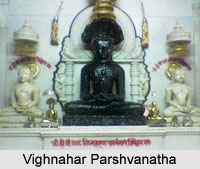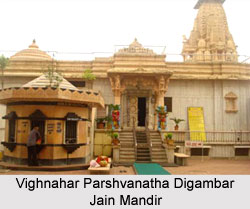Shri 1008 Vighnahar Parshvanatha Digambar Jain Mandir located in Surat District in Gujarat is a Jain pilgrimage centre. It is an Atishaya Kshetra i.e. Place of Miracle. The temple is located on the bank of Poorna River. It is situated on the opposite direction of other Jain kshetras like Pavagarh, Taranga, Gajpantha, Girnar and others that are positioned on the hill.
History of Mahua
 According to history the Vighnahar Parshvanatha Digambara Jain temple was earlier known as Shri 1008 Bhagvan Chandraprabha Digambar Jain Mandir. The village was known as Madhupuri. The wooden pillars of the temple have scripts carved on it. As per these scripts the temple is more than 1000 years old. Later in V. S. 1625 and 1827 the temple was renovated. The huge structure and the construction of the temple reflect that about 1000 years ago the place was densely populated.
According to history the Vighnahar Parshvanatha Digambara Jain temple was earlier known as Shri 1008 Bhagvan Chandraprabha Digambar Jain Mandir. The village was known as Madhupuri. The wooden pillars of the temple have scripts carved on it. As per these scripts the temple is more than 1000 years old. Later in V. S. 1625 and 1827 the temple was renovated. The huge structure and the construction of the temple reflect that about 1000 years ago the place was densely populated.
Vighnahar Parshvanatha Digambar Jain temple is associated with many miracles and legends. According to one legend the idol of Vighnahar Parshvanatha was discovered in a village in the farm of a farmer. The village was in Sultanabad in Pashchim Khan Desh District in Maharashtra. The residents of the village began worshipping the idol and revered it. Later, it was decided to shift the idol to a safe place. Thus a group of people took the initiative to move the idol and placed in their chariot. While traveling efforts were made to stop the chariot and to bring down the idol but all the efforts were in vain. The chariot kept moving and finally it stopped in front of Bhagvan Chandra Prabhu Digamber Jain Mandir. The temple is located in Mahua. The idol of Vighnahar Parshvanatha could easily be brought down from the chariot here. Thus a beautiful temple was constructed here. A Panch Kalyanak Pratishtha Mahotsava was organized and the idol was duly worshipped. It was installed in the main room of the temple. The statue of Lord Chandraprabha also has been installed on the right side and the idol of Lord Shantinath is installed on the left side of the main idol pf Lord Parshvanatha.
It is believed that after the construction of the temple and the installation of the idol of Lord Parshvanatha all the problems of the people began disappearing. The idol is thus known as Vighnahar Parshvanatha. Pilgrims from different places visit the temple and offer their prayers. It is believed that if upon worshiping the idol with full devotion all the desires get fulfilled. Much evidence has been gathered from ancient scriptures. According to the texts of Shri Brahm Gyan Sagar it is clear that various monks and Jains often came here for pilgrimage. A play, `Gyan-Suryodaya Natak` was written in V. S. 1648 by Bhattarak Vadi Chandra, the scholar of Bhattarak Prabha Chandra. Shri Brahm-Harsh, a scholar of Shri Lakshmisen had also described about Shri Parshvanatha of Mahua. Here Panch Kalyanak Pratishtha Mahotsava was organized from 5th June, 1983 to 15th June 1983 in the presence of many monks and famous scholars.
Temple of Vighnahar Parshvanatha Digambar Jain Mandir
 The Temple of Vighnahar Parshvanatha Digambar Jain Mandir is very ancient. It has been magnificently carved with intricate designs and looks very appealing. The temple is dedicated to Lord Parshvanatha. The idol is 47 inches in height and is seated in padmasana posture. The idol of the Lord has been constructed beautifully. Apart from this the idol of Lord Shantinath and Lord Chandraprabha is also installed here.
The Temple of Vighnahar Parshvanatha Digambar Jain Mandir is very ancient. It has been magnificently carved with intricate designs and looks very appealing. The temple is dedicated to Lord Parshvanatha. The idol is 47 inches in height and is seated in padmasana posture. The idol of the Lord has been constructed beautifully. Apart from this the idol of Lord Shantinath and Lord Chandraprabha is also installed here.
The Temple of Vighnahar Parshvanatha Digambar Jain Mandir is located situated at the bank of Poorna River that enhances the beauty of this place. The scenic beauty that adorns the temple premises enthralls the heart of the pilgrims. The calm and soothing natural environment of the place provides the perfect environment for religious purpose. The temple has provisions for dharamshalas or rest houses for the pilgrims.
The Temple of Vighnahar Parshvanatha Digambar Jain Mandir is well connected to road, rail and air. Busses and taxies are available from Surat city. The nearest railway station is located at Surat while the nearest airport is situated at Ahmedabad.









